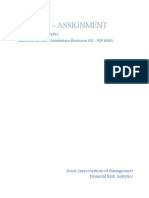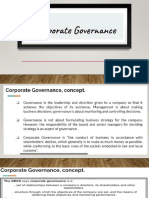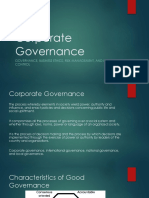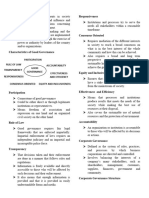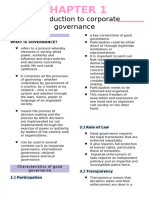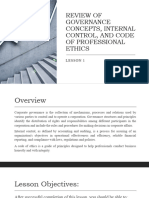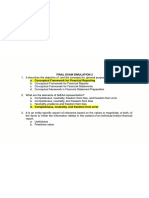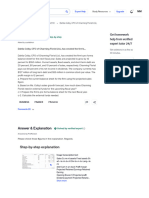0 ratings0% found this document useful (0 votes)
3 viewsGovernance Reviewer
Governance Reviewer
Uploaded by
mmoonique8Copyright:
© All Rights Reserved
Available Formats
Download as DOCX, PDF, TXT or read online from Scribd
Governance Reviewer
Governance Reviewer
Uploaded by
mmoonique80 ratings0% found this document useful (0 votes)
3 views6 pagesCopyright
© © All Rights Reserved
Available Formats
DOCX, PDF, TXT or read online from Scribd
Share this document
Did you find this document useful?
Is this content inappropriate?
Copyright:
© All Rights Reserved
Available Formats
Download as DOCX, PDF, TXT or read online from Scribd
Download as docx, pdf, or txt
0 ratings0% found this document useful (0 votes)
3 views6 pagesGovernance Reviewer
Governance Reviewer
Uploaded by
mmoonique8Copyright:
© All Rights Reserved
Available Formats
Download as DOCX, PDF, TXT or read online from Scribd
Download as docx, pdf, or txt
You are on page 1of 6
1.
_refers to a process whereby elements in Accountability
society wield power, authority, and influence Rule of Law
and enact policies and decisions concerning Responsiveness
public life and social upliftment. Equity and inclusiveness
Effectiveness and efficiency
2. _It means the process of decision-making and
Consensus oriented
the process by which decisions are implemented
4. Participation
(or not implemented) through the exercise of
5. Responsiveness
power or authority by leaders of the country
6. Transparency
and/or organizations.
7. Rule of Law
3. 8 Characteristics of good governance.
8. Consensus oriented
4. _This means freedom of association and 9. Equity and inclusiveness
expression on one hand and an organized civil 10. Effectiveness and efficiency
society on the other hand. 11. Accountability
5. _Good governance requires that institutions and 12. Good corporate governance
processes try to serve the needs all stakeholders 13. Corporate governance
within a reasonable timeframe. 14. The purpose of corporate governance is to
6. _It means that information is freely available enhance the value of shareholders and
and directly accessible to those who will be protect the interest of other stakeholders by
affected by such decisions and their improving the corporates performance and
enforcement. accountability.
7. _Good governance requires fair legal
frameworks that are enforced impartially. It also
requires full protection of human rights,
particularly those of minorities.
8. _Good governance requires mediation of the
different interests in society to reach a broad
consensus on what is in the best interest of the
whole community and how this can be achieved.
9. _This requires all groups, but particularly the
most vulnerable, have opportunities to improve
or maintain their well being.
10. _Good governance means that processes and
institutions produce results that meet the needs
of society while making the best use of
resources at their disposal.
11. _It involves being transparent, following the rule
of law, and being responsible to those affected
by decisions and actions.
12. _is all about controlling one's business and so is
relevant, and indeed vital, for all organizations,
whatever size or structure.
13. _is defined as the system of rules, practices and
processes by which business corporations are
directed and controlled.
14. What is the purpose of corporate governance?
15. 4 objectives of corporate governance.
16. Cite at least 5 principles of good corporate
1. Governance governance and its recommendations.
2. Governance 17. 5 accountability that owners want.
3. Participation 18. 8 parties involved in corporate governance.
Transparency 19. 3 specific activities of BOD.
20. They ensure that the organization is run Maketimelyandbalanceddisclosure.Promotetimel
according to the organization's charter and y andbalanceddisclosureofallmaterialsmatters
that there is proper accountability. concerningthecompany.
21. Provide effective oversight through election 17. Financial performance
of board members, approval of major Financial transparency
initiatives such as buying or selling stock, Stewardship
annual reports on management Quality of internal control
compensation, from the board. Composition of BOD and the nature of its
22. The same as the broad role of the entire activities.
board of directors. 18. Shareholders
23. Provide oversight of the internal and BOD
external audit function and the process of Non-executive andor non-independent directors
preparing the annual financial statements as Audit and committees of the BOD
well as public reports on internal control. Regulators
24. Operations and accountability. Manage the Management
organization effectively: provide accurate External Auditors
and timely reports to shareholders and other Internal Audits
stockholders. Audit committees of the BOD
25. Set accounting and auditing standards 19. Overall operations
dictating underlying financial reporting and Performance
auditing concepts; set the expectations of Compliance
audit quality and accounting quality. 20. BOD
26. Ensure the accuracy, timeliness and fairness 21. Shareholders
of public reporting of financial and other 22. Non-executive andor non-independent directors
information for public companies. 23. Audit committees of the BOD
27. Perform audits of companies for compliance 24. Management
with company policies and laws, audits to 25. Regulators
evaluate the efficiency of operations, and 26. Audits and Committees of the Board of
periodic evaluation and tests of controls. Directors
28. Perform audits of company financial 27. Internal audits
statements to ensure that the statements are 28. External auditors
free of material misstatements including
misstatements that may be due to fraud.
29. Is intended to raise the corporate governance
standards of Philippine corporations to a level at
par with its regional and global counterparts.
30. The system of stewardship and control to guide
organizations in fulfilling their long-term
15. Fair and equitable treatment of shareholders economic, moral, legal and social obligations
Self-assessment towards their stakeholders.
Increase shareholders’ wealth 31. The governing body elected by the stockholders
Transparency and full disclosure that exercises the corporate powers of a
16. Respect the rights of shareholders and facilitate corporation, conducts all its business and
the effective exercise of those rights. controls its properties.
Recognize and manage risk. Establish a sound 32. a group of executives given the authority by the
system of risk oversight and management and Board of Directors to implement the policies it
internal control. has laid down in the conduct of the business of
Promote ethical and responsible decision the corporation.
making. Actively promote ethical and 33. a director who has executive responsibility of
responsible decision making. day-to-day operations of a part or the whole of
the organization.
34. a person who is independent of management
and the controlling shareholder, and is free from
any business or other relationship which could,
or could reasonably be perceived to, materially
interfere with his exercise of independent
judgment in carrying out his responsibilities as a
director.
35. a director who has no executive responsibility
and does not perform any work related to the
operations of the corporation.
36. a group of corporations that has diversified
business activities in varied industries, whereby
the operations of such businesses are controlled
and managed by a parent corporate entity.
37. shall coverthecover the company ’
ssubsidiariessubsidiaries, as well as affiliates and
any party (including theirsubsidiariestheir
subsidiaries, affiliates and special purpose
entities).
38. – a process, effected by an entity ’entity’ s Board
of Directors, management and other personnel,
applied in strategy setting and acrosstheacross
the enterprise that is designed to identify
potential eventsthatevents that may affect the
39. a process designed and effected by the board
entity, manage riskstorisks to be within itsriskits
of directors, senior management, and all
risk appetite, and provide reasonable assurance
levels of personnel to provide reasonable
regarding the achievement of entity objectives.
assurance on the achievement of objectives
29. Code of corporate governance
through efficient and effective operations;
30. Corporate governance
reliable, complete and timely financial and
31. Board of directors management information; and compliance
32. Management with applicable laws, regulations, and the
33. Executive director organization’ s policies and procedures.
34. Independent auditor director 40. a transfer of resources, services or
35. Non-executive director obligations between a reporting entity and a
36. Conglomerate related party, regardless of whether a price is
37. Related party charged. It should be interpreted broadly to
38. Enterprise risk management include not only transactions that are entered
into with related parties, but also
outstanding transactions that are entered into
with an unrelated party that subsequently
becomes a related party.
41. any individual, organization orsocietyor
society at large who can either affect and/or
be affected by the company ’ s strategies,
policies, business decisions and operations,
in general. ThisincludesThis includes,
among others, customers, creditors,
employees, suppliers, investors, as well
astheas the government and community in
which it operates.
42. 7 Board’s governance responsibilities
43. 2 Disclosure and policy
44. The Board should endeavor to exercise
objective and independent judgment on all
corporate affairs.
45. The fiduciary roles, responsibilities and
accountabilities of the Board as provided
under the law, the company ’ s articles and
bylaws, and other legal pronouncements
and guidelines should be clearly made
known to all directors as well as to
stockholders and other stakeholders.
46. The company should be headed by a competent,
working board to foster the long-term success of
the corporation, and to sustain its
competitiveness and profitability in a manner
39. Internal control consistent with its corporate objectives and the
40. Related party transactions long term best interests of its shareholders and
41. Stakeholders other stakeholders.Board committees should be
42. *Establishing a competent board set up to the extent possible to support the
effective performance of the Board’s functions,
*Establishing clear roles and responsibilities
particularly with respect to audit, risk
of the board. management, related party transactions, and
*Establishing board commitment other key corporate governance concerns, such
committees as nomination and remuneration. The
*Fostering commitment composition, functions and responsibilities of all
*Reinforcing board of independence committees established should be contained in a
*Assessing board performance publicly available Committee Charter.
*Strengthening board ethics 47. To show full commitment to the company, the
*Strengthening board ethics directors should devote the time and attention
43. Enhancing company disclosure policies and necessary to properly and effectively perform
procedures their duties and responsibilities, including
*Strengthening the external auditors sufficient time to be familiar with the
corporation ’ s business.
independence and improving audit quality.
48. The best measure of the Board’s effectiveness is
through an assessment process. The Board
Strengthening the external auditors should regularly carry out evaluations to
independence and improving audit quality. appraise its performance as a body, and assess
Increasing focus on non-financial and whether it possesses the right mix of
sustainability reporting backgrounds and competencies.
Promoting a comprehensive and cost- 49. The company should establish corporate
efficient access to relevant information disclosure policies and procedures that are
44. Principle #5: Reinforcing board practical and in accordance with best practices
independence. and regulatory expectations.
45. Principle #2: Establishing clear roles and 50. Members of the Board are duty-bound to apply
responsibilities of the board. high ethical standards, taking into account the
interests of all stakeholders.
51. The company should establish standards for the
appropriate selection of an external auditor, and
exercise effective oversight of the same to
strengthen the external auditor’s independence
and enhance audit quality.
52. The company should maintain a comprehensive
and cost-efficient communication channel for 54. The company should ensure that the material
disseminating relevant information. This channel and reportable non-financial and
is crucial for informed decision-making by sustainability issues are disclosed.
investors, stakeholders and other interested 55. Disclosures can be made using the 3
users. standards/frameworks.
46. Principle #1: Establishing a competent 56. Internal control system and risk management
board. framework.
47. Principle #3: Establishing board 57. To ensure the integrity, transparency and
committees. proper governance in the conduct of its
48. Principle #4: Fostering board affairs, the company should have a strong
commitment. and effective internal control system and
49. Principle #6: Assessing board enterprise risk management framework.
58. How many functions does the internal audit
performance.
have?
50. Principle #8: Enhancing company
59. How many responsibilities does CAE
disclosure policies and procedures.
have?
51. Principle #7: Strengthening board ethics.
60. Cultivating a synergic relationship with
52. Principle #9: Strengthening the external
shareholders.
auditors independence and improving
61. The company should treat all shareholders
audit quality. fairly and equitably, and also recognize,
53. Principle #11: Promoting a protect and facilitate the exercise of their
comprehensive and cost-efficient access rights.
to relevant information. 62. Enumerate at least 3 shareholders’ rights.
63. Duties to stakeholders.
64. A mechanism for employee participation
should be developed to create a symbiotic
environment, realize the company’s goals
and participate in its corporate governance
processes.
65. The rights of stakeholders established by
law, by contractual relations and through
voluntary commitments must be respected.
Where stakeholders’ rights and/or interests
are at stake, stakeholders should have the
opportunity to obtain prompt effective
redress for the violation of rights.
66. The company should be socially responsible
in all its dealings with the communities
where it operates. It should ensure that its
interactions serve its environment and
stakeholders in a positive and progressive
manner that is fully supportive of its
comprehensive and balanced development.
53. Principle #10: Increasing focus on non-
financial and sustainability reporting.
54. G4 framework by GRI
The Integrated reporting framework by IIRC
The Sustainability Accounting Standards
Board (SASB)’s Conceptual Framework
55. Principle #12: Strengthening the Internal
Control System and Enterprise Risk
Management Framework
56. Principle #12: Strengthening the Internal
Control System and Enterprise Risk
Management Framework
57. Eight functions
58. Six responsibilities
59. Principle #13: Promoting Shareholders Rights
Principle
60. Principle #13: Promoting Shareholders Rights
Principle
61. Pre-emptive rights
Dividend policies
Nomination Process
62. Principle #14: Respecting Rights of
Stakeholders and Effective Redress for Violation
of Stakeholder’s Rights
Principle #15: Encouraging Employees’
Participation
Principle #16: Encouraging Sustainability and
Social Responsibility
63. Principle #15: Encouraging Employees’
Participation
64. Principle #14: Respecting Rights of
Stakeholders and Effective Redress for Violation
of Stakeholder’s Rights
65. Principle #16: Encouraging Sustainability and
Social Responsibility
You might also like
- Project Report - FRA V1.0Document28 pagesProject Report - FRA V1.0Bibin Vadakkekara67% (6)
- Detailed Lesson Plan - Fabm 1Document10 pagesDetailed Lesson Plan - Fabm 1Maria Benna Mendiola83% (6)
- Corporate Governance, Business Ethics, Risk Management and Internal ControlDocument91 pagesCorporate Governance, Business Ethics, Risk Management and Internal ControlJoshua Comeros100% (4)
- R14 - UG - Profit Distribution System PDFDocument40 pagesR14 - UG - Profit Distribution System PDFSathya Kumar100% (1)
- Project Proposal For Freight Transport ServivesDocument14 pagesProject Proposal For Freight Transport ServivesJoey MW100% (2)
- Governance ReviewerDocument7 pagesGovernance Reviewermmoonique8No ratings yet
- GBRI Chapter 1-3Document3 pagesGBRI Chapter 1-3FRANCIN MAE LAZAGANo ratings yet
- Governance ReviewerDocument2 pagesGovernance ReviewerTakuriNo ratings yet
- Corporate Governance, Business Ethics, Risk Management and Internal Control CHAPTER 1. Introduction To Corporate GovernanceDocument10 pagesCorporate Governance, Business Ethics, Risk Management and Internal Control CHAPTER 1. Introduction To Corporate Governanceyen yenNo ratings yet
- How Companies Are Directed, Ruled and Controlled: Corporate Governance Is AboutDocument50 pagesHow Companies Are Directed, Ruled and Controlled: Corporate Governance Is AboutnkNo ratings yet
- AE10 MidTerm ExamDocument3 pagesAE10 MidTerm ExamAnne SotalboNo ratings yet
- Govbusman 01Document4 pagesGovbusman 01Keana De GuzmanNo ratings yet
- Cae01 Chapter 1 ModuleDocument8 pagesCae01 Chapter 1 Modulerefuerzorizzamae149No ratings yet
- 01 Introduction To Corporate GovernanceDocument34 pages01 Introduction To Corporate GovernancejhasmineviceraNo ratings yet
- Gov NotesDocument5 pagesGov NotesAndrea Leigh GarciaNo ratings yet
- Corp Governance ReviewerDocument3 pagesCorp Governance ReviewerEstrada, Jemuel A.No ratings yet
- Reviewer in CORPORATE GOVERNANCE-singsonDocument5 pagesReviewer in CORPORATE GOVERNANCE-singsonDonna Mae SingsonNo ratings yet
- AC-MGT102 Reviewer (Quiz)Document10 pagesAC-MGT102 Reviewer (Quiz)ABM-5 Lance Angelo SuganobNo ratings yet
- GGSR Prelim ReviewerDocument12 pagesGGSR Prelim ReviewerRay MundNo ratings yet
- Exam Reviwer in GbermicDocument23 pagesExam Reviwer in GbermicMary Elisha PinedaNo ratings yet
- Code of Corporate Governance For Publicly Listed CompaniesDocument7 pagesCode of Corporate Governance For Publicly Listed CompaniesJoyce Cagayat100% (1)
- Corporate Governance Outline 2Document36 pagesCorporate Governance Outline 2emman neriNo ratings yet
- Governance Chapter 1 & 2Document4 pagesGovernance Chapter 1 & 2Ashlie SulitNo ratings yet
- Bec411 - c1 and c2 StudentDocument74 pagesBec411 - c1 and c2 StudentMargaux CornetaNo ratings yet
- Corporate GOVERNANCEDocument16 pagesCorporate GOVERNANCEkhazzeyurquicoNo ratings yet
- Governance Midterms PDFDocument71 pagesGovernance Midterms PDFRyan Canatuan100% (2)
- All Ppts. Mods1 9 PDFDocument180 pagesAll Ppts. Mods1 9 PDFPauline Rose AnnNo ratings yet
- Governance ReviewerDocument19 pagesGovernance Reviewerdelosreyesjas68No ratings yet
- Ethics and Corporate GovernanaceDocument3 pagesEthics and Corporate GovernanaceAditya MishraNo ratings yet
- Governance Midterm NotesDocument2 pagesGovernance Midterm NotesKristine Angeline CruzNo ratings yet
- Corporate GovernanceDocument40 pagesCorporate GovernanceAnutosh GuptaNo ratings yet
- Governance ReviewerDocument5 pagesGovernance ReviewerMaxine Shia TyNo ratings yet
- 2016 Memo Circular No.19Document42 pages2016 Memo Circular No.19skzsteiNo ratings yet
- Code of Corporate GovernanceDocument12 pagesCode of Corporate GovernanceZsamyla Nikka A. AbrasaldoNo ratings yet
- Corporate Governance: Governance, Business Ethics, Risk Management, and Internal ControlDocument26 pagesCorporate Governance: Governance, Business Ethics, Risk Management, and Internal ControlPipz G. CastroNo ratings yet
- Good GovernanceDocument11 pagesGood GovernanceDizon Ropalito P.No ratings yet
- GovernanceDocument5 pagesGovernanceAnton Biel De LeonNo ratings yet
- Principles and Elements of Good GovernaceDocument30 pagesPrinciples and Elements of Good Governacetabarnerorene17No ratings yet
- GOOD GOVERNANCE AND SOCIAL RESPONSIBILITY Midterm NotesDocument4 pagesGOOD GOVERNANCE AND SOCIAL RESPONSIBILITY Midterm NotesMary Antonette VeronaNo ratings yet
- Mas 4 - Unit 1Document6 pagesMas 4 - Unit 1ERICSON “ERIC” RIRAONo ratings yet
- GovernanceDocument7 pagesGovernanceElle LegaspiNo ratings yet
- Review of Governance Concepts Internal ControlDocument25 pagesReview of Governance Concepts Internal ControlMiller RilleyNo ratings yet
- Gbermic Chapter 3Document14 pagesGbermic Chapter 3Paolo Niel ArenasNo ratings yet
- Bussiness Ethics Chapter 12Document3 pagesBussiness Ethics Chapter 12Ian Farouk Ahmad EstrellaNo ratings yet
- GovernanceDocument8 pagesGovernancePaolo CondinoNo ratings yet
- Governance Reviewer Interim 1Document21 pagesGovernance Reviewer Interim 1batrinafrancinenicoleNo ratings yet
- 2016 Memo Circular No.19Document42 pages2016 Memo Circular No.19alicianatalialevisteNo ratings yet
- Governance ReviewerDocument8 pagesGovernance ReviewerMaxine Shia TyNo ratings yet
- Part 1 of Module I GBERMICDocument12 pagesPart 1 of Module I GBERMICjhie boterNo ratings yet
- CCSFP Gbermic Chapter-2Document13 pagesCCSFP Gbermic Chapter-2Paolo Niel ArenasNo ratings yet
- Corporate Governance 2021Document21 pagesCorporate Governance 2021Kelebogile MoesiNo ratings yet
- Reviewer in GBRC PRELIMDocument2 pagesReviewer in GBRC PRELIMJhernel SuaverdezNo ratings yet
- 2016 Memo Circular No.19Document42 pages2016 Memo Circular No.19Iman HassanNo ratings yet
- WEEK 2-3 Corporate - Governance Module - January 23, 2023Document21 pagesWEEK 2-3 Corporate - Governance Module - January 23, 2023Sergie JaraNo ratings yet
- Corporate Governance and Social ResponsibilityDocument7 pagesCorporate Governance and Social ResponsibilityMohitNo ratings yet
- SEC Code of GovDocument34 pagesSEC Code of GovYakejjzNo ratings yet
- Corporate GovernanceDocument23 pagesCorporate GovernancesayedNo ratings yet
- Don Honorio Ventura State University College of Business StudiesDocument12 pagesDon Honorio Ventura State University College of Business StudiesMariz TrajanoNo ratings yet
- Corporate Governance Notes - Part 1Document24 pagesCorporate Governance Notes - Part 1Xyza Faye RegaladoNo ratings yet
- Governance - Chapter 1Document14 pagesGovernance - Chapter 1pamela.luna041605No ratings yet
- Corporate Governance For PrintingDocument31 pagesCorporate Governance For PrintingAndi Te'a Mari O. SimbalaNo ratings yet
- Corporate Governance: Shivani MahajanDocument3 pagesCorporate Governance: Shivani MahajanShivani MahajanNo ratings yet
- 01 Handout GovernanceDocument16 pages01 Handout GovernanceDavid Christine L.No ratings yet
- "Reigning the Boardroom: A Trailblazing Guide to Corporate Governance Success": GoodMan, #1From Everand"Reigning the Boardroom: A Trailblazing Guide to Corporate Governance Success": GoodMan, #1No ratings yet
- Chapter 6 - Solution Income Taxation BanggawanDocument9 pagesChapter 6 - Solution Income Taxation BanggawanGWYNETH NICOLLE PESIDASNo ratings yet
- SRO-156 (OIT Rules)Document17 pagesSRO-156 (OIT Rules)Colors of LifeNo ratings yet
- CIMB-Principal Bond FundDocument2 pagesCIMB-Principal Bond FundAnonymous EA18Sp3Y0No ratings yet
- Transactions List - Service and MerchandisingDocument9 pagesTransactions List - Service and MerchandisingVISITACION JAIRUS GWENNo ratings yet
- Acotel 2008 Annual ReportDocument157 pagesAcotel 2008 Annual Reportg00031065No ratings yet
- Chapter 16 Cash FlowsDocument4 pagesChapter 16 Cash Flowsjou20220354No ratings yet
- Instant download Financial Reporting, 3rd Edition Janice Loftus pdf all chapterDocument50 pagesInstant download Financial Reporting, 3rd Edition Janice Loftus pdf all chapterdiniaadolg100% (3)
- Efficiency Ratios For UNION BANKDocument16 pagesEfficiency Ratios For UNION BANKKazi Sajharul Islam 1410028630No ratings yet
- Corporate Governance: Prof. Eloida C. DagumboyDocument18 pagesCorporate Governance: Prof. Eloida C. DagumboyirenesyNo ratings yet
- Final Exam Simulation 2Document32 pagesFinal Exam Simulation 2Carmel Rae TalimioNo ratings yet
- Challenges On Implementation of Practice of Corporate GovernanceDocument3 pagesChallenges On Implementation of Practice of Corporate GovernanceturjoyNo ratings yet
- PROBLEMsDocument3 pagesPROBLEMsHancel NageraNo ratings yet
- Nou B.Com. Part I, II and IIIDocument22 pagesNou B.Com. Part I, II and IIIsufistories storiesNo ratings yet
- Cfas - Chapter 8: Pas 1 - Presentation of Financial STATEMENTS (Statement of Financial Position)Document2 pagesCfas - Chapter 8: Pas 1 - Presentation of Financial STATEMENTS (Statement of Financial Position)agm25No ratings yet
- Descriptive Essay Writing What Is Basel Norms and Are Indian Banks Ready For It PDFDocument2 pagesDescriptive Essay Writing What Is Basel Norms and Are Indian Banks Ready For It PDFVirendra kambliNo ratings yet
- 325 PDFDocument10 pages325 PDFAashish SarotiaNo ratings yet
- Chapter 04 Corporate Governance Foundational IssuesDocument38 pagesChapter 04 Corporate Governance Foundational IssuesKhánh Linh LêNo ratings yet
- Chapter 5 - 6 - Inventory Accounting and ValuationDocument61 pagesChapter 5 - 6 - Inventory Accounting and ValuationNaeemullah baig100% (1)
- Radiance Group LTD 2010 Annual ReportDocument92 pagesRadiance Group LTD 2010 Annual ReportWeR1 Consultants Pte LtdNo ratings yet
- (Solved) Dahlia Colby, CFO of Charming Florist LTD., Has Created The Firm's... - Course HeroDocument3 pages(Solved) Dahlia Colby, CFO of Charming Florist LTD., Has Created The Firm's... - Course Heromisonim.eNo ratings yet
- Article - 06 واقع المحاسبة في قطاع البناء ScfDocument12 pagesArticle - 06 واقع المحاسبة في قطاع البناء Scfعبد العالي محمديNo ratings yet
- Managerial Finance Online Exam-BDocument4 pagesManagerial Finance Online Exam-BHany BadrNo ratings yet
- BIWS LBO Case Study - VFDocument2 pagesBIWS LBO Case Study - VFLoïc HalleuxNo ratings yet
- Equity ValuationDocument12 pagesEquity ValuationDiệu HuyềnNo ratings yet
- AR ACIDATAMA 2017 - SRSN - 090418-2 PDFDocument121 pagesAR ACIDATAMA 2017 - SRSN - 090418-2 PDFMrclnofebrianoNo ratings yet
- Corporate Finance: Laurence Booth - W. Sean ClearyDocument136 pagesCorporate Finance: Laurence Booth - W. Sean Clearyatif41No ratings yet
